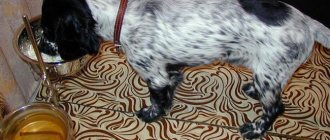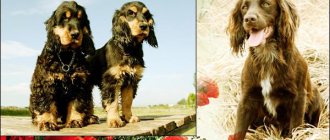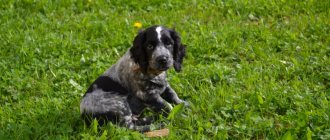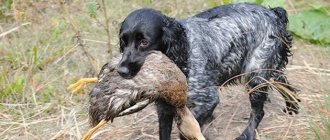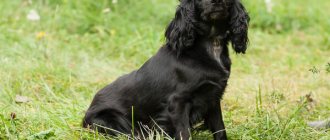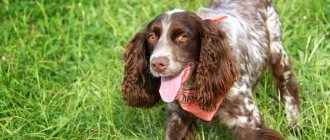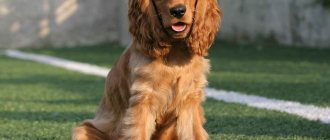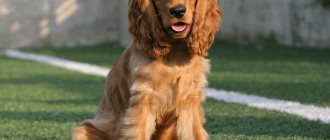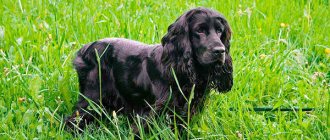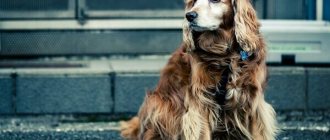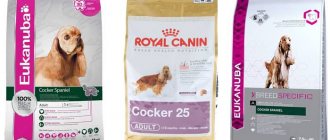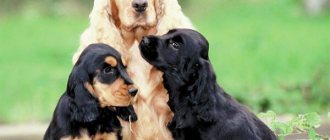| Origin: | Soviet Russia, 1951 |
| Usage: | for hunting wild birds and hare |
| Color: | solid, piebald, spotted |
| Dimensions: | height - 36-44 cm; weight – 13-20 kg |
| Lifespan: | 12 years |
The Russian hunting spaniel is a breed belonging to the gundog type. To date, this is the only variety of the mentioned type that has been obtained through well-organized selection in Russia. For some reason, the standard has not yet been adopted by the FCI, but we have it defined, and the breed has received the right to exist since 1951. Reviews about the Russian hunting spaniel are positive. Owners note high intelligence and extraordinary natural abilities to detect game. The English cocker and springer spaniel were actively used in breeding.
Breed characteristics
| Short description | |
| Origin: | Russia |
| Conditions of detention: | House with or without garden, apartment |
| Purpose: | Hunting dog, companion dog |
| Color: | Solid solid black, tan or chocolate brown, white markings acceptable |
| Wool length: | Long |
| Adult dog size: | Female height – 36-42 cm, male height – 38-44, weight – 15-20 kg |
| Average life expectancy: | 10-12 years |
| Walk: | Need active walking twice a day |
| Physical activity needs: | High physical activity needs (1.5-2.5 hours of walking or training) |
| Classification of the Russian Cynological Federation (RKF): | Group 8: Retrievers and Gun Dogs, Section 2: Gun Dogs |
| Puppy price: | From 3,000 to 20,000 rubles. Without pedigree – 3000-5000 rubles, pet class – 10000 rubles, breed class – 15000 rubles, show class – 20000 rubles |
Medium Spaniels
Representatives of medium-sized spaniels were bred exclusively for hunting. In modern times, these dogs began to be used as companion dogs. Their height is on average 39-41 cm.
Descriptions of the types of medium spaniels with names are presented below.
American Water Spaniel
| Country of origin | USA |
| Lifespan | 13-15 years old |
| Height at withers | up to 46 centimeters |
| Body mass | up to 20 kilograms |
An agile hunting dog capable of working both in water and on land.
American Water Spaniel description.
The breed has a strong body of medium size. The skull is wide and moderately long, the muzzle is slightly blunt. The ears are long, located above eye level, and covered with curly hair.
This breed has a dense coat consisting of small curls.
Coat color is all shades of brown, light spots on the chest and paws are acceptable.
The American Water Spaniel is not demanding in terms of grooming. However, it is important to provide the dog with active and long walks.
The character of the American Spaniel is calm and friendly. The dog is not prone to aggression towards strangers and children. The breed tends to choose one owner in the family and obey him unquestioningly.
American Cocker Spaniel
| Country of origin | USA |
| Lifespan | 12-15 years |
| Height at withers | up to 39 centimeters |
| Body mass | up to 15 kilograms |
One of the most popular spaniel breeds, which has lost the need for working qualities.
The American Cocker Spaniel has a strong body of small size. The standard of the breed is considered to be a square-shaped muzzle with a pronounced vertical edge. The ears are quite long and abundantly covered with hair. Cockers are famous for their incredibly long eyelashes.
The Cocker Spaniel has a very soft and silky coat. The coat is short-haired on the head, and very long and wavy on the body, legs and ears.
The color of Cocker Spaniels is quite varied. Main types of spaniel colors:
- black
- black and tan
- light fawn
- chocolate
- brown
- white-red
The American Cocker Spaniel requires special care. The dog needs proper training and professional grooming.
Living conditions are less important for this breed. Cockers are equally comfortable living both in an apartment and in a private house. The main thing for a dog is a long active walk.
The Cocker Spaniel is a dog whose energy seems endless. Typically, representatives of this breed are friendly towards people and dogs around them, and also get along well with children. But without proper training, a dog can start biting. These spaniels require a strong owner. The cute appearance is quite deceptive; owners need to understand that the breed is primarily a hunting breed.
Another feature of cockers is their intolerance of loneliness.
If a dog is left to its own devices in an empty apartment, it will begin to bark and damage furniture and things.
To prevent this, try to devote more time to your four-legged friend. In return you will receive the love and devotion of a cocker spaniel.
With professional training and active walks, the Cocker Spaniel will become an ideal family pet.
English cocker spaniel
| Country of origin | Great Britain |
| Lifespan | 12-14 years old |
| Height at withers | up to 41 centimeters |
| Body mass | up to 15 kilograms |
One of the most popular spaniel breeds, often used to detect illegal substances
The body of the English Cocker is quite compact, but at the same time strong. The skull is moderately short, the muzzle is proportional with a prominent stop. The long ears are set low.
The coat is very soft, curling on the belly, paws and ears.
The color of the English Cocker Spaniel can be solid, tri-color, spotted and speckled. For example:
- black
- golden
- chocolate
- fawn with white specks
- black with white specks
- red roan
- blue roan
- black and white with tan
The English Cocker Spaniel breed requires special care. To maintain beauty, the dog periodically requires the services of professional groomers.
English Cockers combine friendliness and energy, as well as stubbornness. Therefore, the dog requires training from an early age and active daily walking.
Representatives of the breed love to bark, sometimes for no reason. They are very friendly to all family members, but the owner comes first for them.
When walking, the English Cocker always explores the area; he sniffs every inch of the ground. When interacting with other dogs, cockers always initiate play.
This breed loves to play with children, but does not allow itself to be caused discomfort or pain.
The English Cocker Spaniel will be an excellent companion and best friend for an active family who loves to travel.
Dutch Spaniel (Kooikerhondje)
| Country of origin | Holland |
| Lifespan | 12-14 years old |
| Height at withers | up to 40 centimeters |
| Body mass | up to 15 kilograms |
An incredibly smart dog that works in tandem with a human on the hunt.
Kooikerhondje has a dry elongated body. The skull is rounded with a smooth occipital protuberance, the muzzle is elongated. The ears are long, low set, and have feathering.
The distinctive features of these spaniels are their expressive gaze, in which the dog’s intelligence is read, and a fluffy white tail. It is believed that ducks flock to the movement of the tail.
Kooikerhondiers are not picky about caring for their fur. The dog is suitable for keeping in an apartment, a private house, and even in an aviary.
Dutch Spaniels are bred to hunt ducks. If the owner is going to take the dog hunting, then for this he needs to purchase traps for game. The Dutch drive their prey into a trap prepared in advance by the owner.
Kooikerhondje never experience aggression. Even when hunting, they never touch their prey. Therefore, the dog is ideal for keeping in a family.
This breed is very affectionate and gentle. The animal loves to spend time with his family and does not tolerate loneliness at all. When separated from its owner, the dog is able to completely refuse food and drink.
These dogs are friendly with children, but do not tolerate causing inconvenience or pain. The dog most likely will not bite the child, but will certainly warn of discomfort by growling.
The Dutch Spaniel is perfect for people who dream of an intelligent, energetic and kind four-legged friend.
Russian Spaniel
| Country of origin | Russia |
| Lifespan | 12-14 years old |
| Height at withers | up to 44 centimeters |
| Body mass | up to 20 kilograms |
The only Russian gun dog
The Russian spaniel has a squat, long body with well-developed muscles. The skull is quite powerful and wide, the muzzle is elongated. The ears are long with rounded tips.
The spaniel's coat is thick, straight or slightly wavy. There is a dense undercoat.
The color can be piebald and spotted, and solid. In the first type, sparse and dense speckling is acceptable. The second has white markings on the throat, chest and paws.
It is the piebald and spotted color that is an attractive feature of the Russian Spaniel.
The Russian Hunting Spaniel does not require complex care. Able to live in an apartment or private house.
The domestic breed of spaniels fully reveals their working qualities when hunting. These dogs are very hardy, brave and smart. It is not for nothing that Russian spaniels are involved in search operations of the police and rescuers.
After the work is done, this breed becomes an ordinary apartment dog. At home they are calm, friendly to children and other animals, and welcome guests.
Dogs are ready to tolerate small children's pranks and living together with cats. The most favorite games of Russian spaniels are searching and fetching objects.
The Russian Hunting Spaniel is an ideal dog for hunting and family
Sussex Spaniel
| Country of origin | Great Britain |
| Lifespan | 10-14 years |
| Height at withers | up to 42 centimeters |
| Body mass | up to 23 kilograms |
Hunting spaniels with great strength and endurance
Sussex spaniels have a large and long body with pronounced muscles. The skull and muzzle are wide. The ears are drooping and long, covered with long hair.
Outwardly, Sussexes look gloomy and serious. This impression is created due to the expression of the eyes and heavy eyebrows.
The dog's coat is silky and thick. There is undercoat. The hair reaches its maximum length on the paws, chest and ears. The color of the breed always has only one shade - golden chestnut.
Sussex Spaniels do not require special care. The dog feels comfortable both in an apartment and in a country house.
This breed is friendly towards other dogs and people. Does not experience aggression, gets along well with children.
Their calm and good-natured disposition makes these spaniels an ideal family pet, and their excellent working qualities allow the dog to become a hunting companion.
Field Spaniel
| Country of origin | Great Britain |
| Lifespan | 10-12 years |
| Height at withers | up to 46 centimeters |
| Body mass | up to 25 kilograms |
Born hunters with enviable instincts and dedication
The body of the Field Spaniel is of medium length and well-muscled. The skull is ovoid, the muzzle is narrow and long. The ears are of the hanging type, wide at the tips and covered with wavy hair.
A distinctive external feature from other spaniels is their darker color. It is almost always monochromatic (rare, but there are tan and white marks).
The dog's coat is moderately long and shiny. There is no undercoat.
In general, caring for a Field Spaniel is not difficult. However, these dogs have very high energy levels and living in a city apartment is not for them. It is recommended to keep this breed in a private home.
Without a burst of energy, Field Spaniels begin to get bored. For this reason, they may become depressed or become very noisy.
Also, puppy owners should know that this breed of spaniel is very vulnerable; every minor failure makes the dog worry. If something doesn’t work out for your dog, don’t yell at it, but rather encourage and support your pet as your best friend. With proper training and active walks, Field Spaniels are excellent family dogs.
Field Spaniels are sociable, intelligent, absolutely non-aggressive and kind to other animals and children.
History of the origin of the species
The idea to develop a new hunting breed came to Russian breeders at the end of the 19th century, when European Spaniels, which were good at hunting, but were not suitable for the climate, began to be imported into the country. Active work began, the long-legged Cocker and Spring Spaniels were crossed.
The Russian Spaniel is considered one of the youngest Russian hunting breeds. The breed took its final form in the mid-20th century; a standard was developed in 1951 1966 . But before this, the breed line was not perfect. Dogs no longer resembled their ancestors, but still did not constitute a single new type. Since 1972 , dogs are no longer modified.
The animals are still not recognized by the International Canine Organization, although in Russia they are highly valued for their versatility. Russian spaniels hunt any feathered game, hares and small fur-bearing animals.
Pros and cons of the breed
Advantages of Russian Spaniels:
- The dimensions allow you to keep the animal in apartment conditions, as well as transport it in a bag on public transport.
- High intelligence.
- Easy to learn.
- A small percentage of genetic abnormalities.
- The presence of hunting instincts in the blood.
- Compatibility with other animals.
- Good attitude towards children.
- Devotion to the owner.
The disadvantages include:
- The difficulty of hunting in difficult conditions. In tall grass, a spaniel quickly loses strength.
- Inability to keep exotic rodents and birds together, which will be perceived as prey.
- Hyperactivity of young individuals.
- Proneness to ear infections due to the structure of the ear.
Distinctive features
This breed is medium-sized, well-built, with a strong body and well-developed muscles. A feature can be considered long hair and variability of colors. At the withers, the animals reach 36-44 cm, and weigh from 15 to 20 kg.
Spaniels are stretched in structure. Their body length is slightly greater than their height. Their limbs are quite long, which makes them adaptable to running through swamps or snowdrifts. The latest standard was published in 2012.
- The head is dry and long. The skull is oval, with a pronounced smooth stop and brow ridges.
- The muzzle is moderately long, narrow (tapering towards the nose), filled in under the eyes. The jaws are strong but soft, with a full set of teeth and scissor bite The lips are thin and pigmented.
- The nose is wide with open nostrils.
- The eyes are medium-sized, oval, not widely set. The color of the iris depends on the coat color: from light brown to dark brown.
- The ears are set at eye level, long, thin, adjacent to the cheekbones;
- The body is streamlined and strong. The back is long and wide. The loin is slightly convex. The croup is sloping. The withers are pronounced. The chest is deep and well descended. The neck is of moderate length, dry, muscular. The belly is tucked in.
- The tail is a continuation of the croup, moderately long, carried at the level of the back or slightly above it. It is docked by half, unless it is prohibited in the country.
- The limbs are dry, straight, parallel, the hind legs are set wider than the front ones. The paws are oval with gathered toes, characterized by the presence of hair between them. Movement : light gallop.
- The coat is straight or wavy, moderately long, close-lying and shiny. Lengthening is noticeable on the ears, limbs, abdomen, chest and neck.
- Colors: solid, bicolor or tricolor in various variations.
Description of the standard
The Russian Hunting Spaniel breed standard defines the following parameters:
- the build is strong, only slightly squat;
- the constitution is dry and toasty;
- hard bones of the body, muscles are well developed;
- chest of good width, deep in shape, elongated;
- pronounced withers, slightly larger in males;
- a strong back of sufficient width with a straight line, which slopes very slightly from the withers to a short loin with strong muscles;
- the croup muscles are well developed;
- the stomach is tucked;
- There are no folds on elastic skin with good density;
- the head is long, but in moderation, with a wide, slightly elongated skull, a convex forehead, and an indistinct occiput;
- the transition between the forehead and muzzle is noticeable;
- the dog's muzzle is slightly narrower than the skull and further tapers towards the nose;
- lips and nose are significantly pigmented - from light brown to black;
- strong teeth in a tight scissor bite;
- the eyes are large, brown, of varying color saturation and oval in shape;
- the ears are long and have a noticeable width, they hang low, close to the head, their setting is slightly above or level with the eye sockets;
- The muscular, medium-long neck is set rather low.
Gender is clearly expressed. Bitches are smaller in size, but their back length is longer and their head is narrower than that of males.
In the photo, the Russian hunting spaniel froze in the exhibition stand, demonstrating the presented description of the breed, in accordance with the listed points of the standard.
The forelimbs occupy visually 50% of the dog's height at the withers. They are straight and parallel to each other. The hind legs are set wider apart with a pronounced angle of articulation and voluminous erect metatarsals.
The Russian Cocker Spaniel breed is famous for its movements, characterized by the ease, speed and sweeping running of a hunter.
The tail of representatives of the breed is docked to half its natural length. When the dog is in a standing position, it forms a single straight line with the back.
Coat type and colors
The spaniel bred in Soviet Russia is more smooth-haired than its European ancestors. The Russian Spaniel standard requires a medium-long coat, a close fit, and slight waviness is allowed. The dogs' paws and head are covered with short hair, and the rest of the body is long-haired. Ears and tail with feathering.
Hunting spaniel.
Russian spaniels inherited varieties of colors from their numerous different types of ancestors:
- black;
- chocolate;
- ginger;
- mottled;
- black and piebald;
- brown-piebald.
When the puppies are one month old, the mottled color becomes visible. And the seven-month-old baby is already acquiring a permanent coat color.
Interesting! If the puppy’s parents are both contrasting subtypes, then they cannot give birth to speckled-colored babies. And from a speckled mother and a contrasting father, the speckled color will become dominant.
Photo of an adult dog
Hunting with a Russian Spaniel
The Russian hunting spaniel is a gun dog, used in hunting field, forest, swamp, and meadow game. The spaniel is an excellent swimmer and dives after a wounded duck. The dog’s task is to find the bird, lift it on its wing, and then, on command, bring the wounded animal to its owner. Very rarely, but Russian spaniels are also used for blood trail hunting.
Among themselves and on forums on the Internet, hunters use the abbreviation ROS to designate the breed.
Working style
When searching, it moves at a light, fast gallop. Top flair is preferred, but the spaniel may lower its head below the level of its back during tracking work. A well-positioned dog itself determines a rational search pattern depending on the terrain and wind direction. Constantly in contact with the owner, periodically looks back at him, and in areas with high vegetation, jumps out of the grass, making a candle. This allows you to catch the upper odorous air currents and visually determine the location of the owner. When the spaniel scents prey, it suddenly perks up and lets the hunter know the location of the bird. At the moment of lifting, the dog stops. He finds the downed bird without delay and delivers it with a soft grip.
Photos of puppies
Selection and price of a puppy
Hunters are well aware of the importance of adopting a puppy from working parents. Hereditary inclinations will certainly manifest themselves in practice.
When choosing a dog, you can go two ways. The first is to find a baby from an unplanned mating, without documents, but cheaper, and take the seller’s word that this is a litter from real working parents. The second option is to choose a puppy exclusively from nurseries that are more strict in the selection of breeding studs; the dogs have high scores for exterior appearance and working diplomas confirming hunting skills.
A true working spaniel should have diplomas in the main types of game birds.
Of course, it will be difficult for beginners to understand all the intricacies, ranks and titles, so many turn to the Service Dog Club for help or find a spaniel expert on thematic forums.
There is no point in looking at a puppy before one month of age, when neither character nor external characteristics are visible. Babies are chosen, usually from 8-10 weeks. An active, energetic, flirtatious puppy will be eager to hunt. More phlegmatic puppies are better suited to apartment life. Externally, babies should be healthy. By the age of 3 months, they should be dewormed and given their first vaccinations.
The price of a puppy varies over a very wide range. You can buy a dog second hand for a symbolic price. Sometimes there are advertisements for the sale of a Russian hunting spaniel for 500-1000 rubles. If we talk about puppies from working parents, but without documents, the price range usually ranges from 5,000-15,000 rubles. Puppies from nurseries from award-winning producers with working diplomas cost 15,000-25,000 rubles.
Features of character and behavior
The Russian Spaniel is an excellent pet and companion. He is active, friendly and devoted to his owner. The breed has not lost its hunting qualities and still serves people.
These dogs are characterized by intelligence and ingenuity, independence in decision-making, good reaction, and endurance. All these qualities become indispensable in the forest.
Advantages
The breed was bred for hunting, so it has a full range of necessary physical qualities:
- Acute vision and sense of smell;
- Energy;
- Endurance;
- Resistance to cold and dampness;
- Strong skeleton and developed muscles.
Animals learn quickly and understand all commands.
Russian spaniels love their family, get along with children, and listen to their owner. They will be happy to serve a person, spend all their time with him: lying on the couch or climbing into a cold swamp. They like to run with their owner, play with family members, and bring toys. These dogs are very active and remain playful almost into old age.
They get along well with other pets and livestock. They communicate well with both dogs and cats, despite the fact that they are hunters.
Flaws
- Spaniels can be stubborn, intractable, and often try to dominate.
- They really need good upbringing and a firm hand, otherwise they will grow up to be an uncontrollable pet.
- They are real destroyers: they love to gnaw, break, tear, scratch. Everything that lies badly will be picked up, studied and spoiled by this pet.
- They cannot serve as guards. Representatives of the breed are friendly and do not see danger in humans. Besides that, they just bark.
- They are gluttonous and have no sense of proportion. This makes walking much more difficult. If the bad habit of picking up from the ground was not eliminated during puppyhood, then you can forget about walking without a leash.
- They can be aggressive towards other people's children and do not like noise, shouting and bullying.
Application
The hunting instincts of the Russian Cocker Spaniel allow it to be used as a companion for outdoor games. This dog will tirelessly search for and bring a stick or toy, delighting the kids.
The dog’s increased energy, intelligence, subtle sense of smell, tirelessness, perseverance and patience during long walks and searches for birds are qualities inherent in a hunter, which were instilled through selection. This dog is ideal for hunting wild birds. She also loves to swim, getting birds out of ponds.
For an owner who loves long hikes in nature, a dog of the Russian Spaniel breed will become a faithful companion.
Care and maintenance
These dogs can be kept both indoors and outdoors. They feel comfortable in various conditions and can tolerate any temperature. Of course, like every hunting dog, the Spaniel will be happy to spend all his time outside, where he can chew, sniff, and search.
If you plan to keep an enclosure or kennel, then you need to provide the dog with warm bedding and a strong canopy that will protect it from sunlight and precipitation. The puppy will also need a tray for the primary toilet, toys and bowls on stands.
Apartment housing is no different from street housing, but the dog will need less food. You need to choose a place for your pet that is free from sunlight and drafts; the closer to the owner, the better.
In general, these animals are unpretentious. They do not require careful care, they eat what they give. But they need to be provided with frequent regular walks, exercise and brushing.
Nutrition
Spaniels are hunting dogs that need a lot of energy and strength, so their nutrition must be complete. More and more breeders prefer dry food, despite its bad reputation. The fact is that finished products are much easier to store and use, they contain a complex of necessary substances for dogs, in addition, separate lines have been developed for active and sedentary, sick pets, allergy sufferers, pregnant and lactating bitches.
Poor quality food may contain unnecessary substances that complicate digestion, have a negative effect on organs, and contribute to excess weight gain. Spaniels are suitable for premium holistic (grain-free) food for active medium-sized breeds.
We recommend that you read a detailed article on the topic: “How and what to feed a dog: types and characteristics of nutrition.”
These pets are prone to obesity, so the amount of food should vary depending on the activity of the animal.
On average, an adult spaniel needs 400-600 grams of food diluted with water per day. In summer, the portion is reduced, and in winter it is increased. Puppies up to 3 months are fed 5-6 times , up to 6 months - 3-4 times , and by the year they switch to two meals a day.
Usually the nursery gives advice on keeping and feeding the puppy. The breeder recommends a specific type and brand of food, the one the dog was fed before purchase. If the owner is planning a transition, then this should be done smoothly: feed the pet with the products included in the composition or choose a similar food.
For this breed, you can choose natural feeding. It is healthier and better absorbed, and the owner knows what exactly he is giving to the pet. The downside is the time spent and the inconvenience of storage and use.
The basis of the menu of such a diet should be protein:
- Lean meat;
- Dairy products;
- Boiled sea fish without bones;
- Eggs.
Don't forget about carbohydrates: grains, cereals. The dog must be accustomed to vegetables and fruits.
The menu should not include:
- Butter;
- Legumes;
- Starchy vegetables and fruits;
- Bones;
- Pork;
- Citrus;
- Flour and confectionery products;
- Smoked, fried and fatty.
Your pet's food should be of medium temperature and medium consistency. Puppies are given more food than adults. From 5-6 months you can give large pieces for chewing. Mixing dry and natural food is not allowed .
Low-fat cheeses and special treats from the pet store are suitable as treats.
It is important to maintain a drinking regime. In summer, the volume of water needs to be increased. It is important not to forget to take a container of drink for a walk.
Health
This breed can be considered truly Russian. Its representatives are not afraid of frost, work and changes in living conditions. These Spaniels are in good health, they live from 10 to 12 years , with ideal care 13-14 years . But like all long-haired, long-eared hunting breeds, they are prone to skin diseases, ear problems and digestive problems.
In addition, dogs are at particular risk of contracting an infectious disease. Therefore, you should not neglect vaccination.
Vaccinations
Hunting dogs are in dire need of vaccination because they deal with wild animals, which are often carriers of diseases. Even if the dog is not walked, vaccinations must be done, since a person can carry viruses on his clothes.
Vaccination does not provide 100% protection against infections, but it prevents their development and helps the pet recover from infection. Unfortunately, unvaccinated puppies will die if they become ill.
Usually the nursery does the primary vaccinations, and the breeder prepares the necessary documents, including a veterinary passport. The owner will be informed of the vaccination schedule that must be followed.
- The first procedure is carried out when the puppy reaches 2 months . At this time, the immunity given to him by his mother stops working. The drug is complex and contains a vaccine against major infectious diseases, such as plague and leptospirosis.
- The vaccination is repeated at 2.5, 6, 12 months and annually.
- The second important vaccination is against rabies. The drug is administered to a seven-month-old puppy. The procedure requires annual updating because it loses its effect. This vaccination is considered the main one for exporting an animal abroad.
Two weeks before vaccination, the dog must be dewormed. Before the procedure, the pet’s temperature is measured; the normal value (37-39°C) should not deviate.
Vaccination is carried out by specialists at equipped points. In case of an allergic reaction, the animal is given an antidote. If negative side effects occur for more than a day, you should consult a doctor.
The cost of vaccination depends on the weight of the pet and the percentage charged by the veterinary clinic. Usually it varies from 400 to 1000 rubles.
Important article on the topic: “Everything you need to know about dog vaccinations.”
Diseases
Health problems that are most common in this breed include:
- Skin diseases: dermatomycosis (lichen), piroplasmosis (a disease carried by mites), demodicosis (mites getting into hair follicles), sarcoptic mange (scabies);
- Diseases of the digestive system: obesity, allergies, indigestion;
- Inflammation of the ears, otitis media;
- Epileptic seizures.
Walk
This breed is extremely active. Dogs show it both at home and on the street.
With insufficient training and physical activity, the Spaniel will destroy the house: gnawing, breaking, carrying furniture and things. An adult dog needs an active walk twice a day for 1.5-2 hours.
Walking can begin after the second vaccination. The puppy is carried out in their arms and introduced to nature. After 2-3 weeks, you can learn to walk on a leash. Small dogs are walked 3-4 times a day for 20 minutes. They must get used to their environment and strangers.
The next step of socialization is getting to know other animals. Spaniels get along well with dogs and love to play with them, but the owner should always focus the pet's attention on himself. The puppy should know that it is always more interesting with a person.
The final stage will be walking the animal in noisy, crowded places . This is necessary so that the adult Spaniel is not afraid of sharp sounds, large moving objects, or passers-by. An unsocialized dog can become timid or aggressive.
For an adult pet, hunting will be an excellent walk and exercise. If it is not possible to organize a real one, then you can take the dog to the forest or planting, where it can show all its best qualities.
Spaniels make good partners for running and other sports activities. They love to play ball, fetch sticks, and chase bicycles.
Grooming
In caring for a Spaniel, the following main points can be distinguished:
- Combing must be done at least 2-3 times a week, and during seasonal shedding, daily combing with a stiff brush is required;
- bathe your pet no more than 2-3 times a year; the coat of these dogs has a protective barrier against pollution and does not emit unpleasant odors;
- If the pet is not a show pet , haircuts are allowed (2-3 times a year);
- After walks and when heavily soiled, dogs are wiped with a damp towel and their paws are washed under warm water;
- The ears are considered the weak point of all Spaniels; they are poorly ventilated due to their specific shape; they must be examined daily, checking for the presence of inflammatory processes;
- Teeth are checked twice a week, brushed with special pastes or chewing cords;
- The claws usually grind down on the asphalt; if they grow too long, they require trimming with a nail clipper once a month;
In the warm season, treatment against fleas and ticks using shampoos, solutions, powders or a collar is mandatory. Every 2 months a deworming procedure (cleansing from worms) must be carried out.
Large Spaniels
Representatives of large breeds of spaniels are excellent for hunting game birds and small animals.
Their height on average is 48-63 cm. Characteristics of the species with names are presented below.
English Springer Spaniel
| Country of origin | Great Britain |
| Lifespan | 12-14 years old |
| Height at withers | up to 50 centimeters |
| Body mass | up to 23 kilograms |
The fastest representative of the breed
The British Springer has a powerful body with a deep chest and a large skull with a rectangular muzzle. The dog's ears are long and wide, his eyes are medium-sized with a lively and friendly look. The dog's coat is thick, smooth and not too long.
Coat color:
- liver-white (brown-white)
- black and white
- any of the above with tan
Due to the lack of undercoat, this large spaniel does not tolerate cold weather well and is not capable of living in an enclosure.
This type of spaniel is a natural hunter, designed to track and scare away prey.
Springer spaniels have incredible affection for their owners and love for children. They get along well with other animals, are calm with strangers and easily adapt to changes in housing. All these qualities make the dog ideal for the family and for hunting.
Breton epañol
| Country of origin | France |
| Lifespan | 12-13 years old |
| Height at withers | up to 52 centimeters |
| Body mass | up to 19 kilograms |
Elegant representatives of the spaniel breed, combining all the useful qualities of hunting dogs
The Breton Spaniel has a “square body”, in other words, the height is equal to the length of the body. The skull is flattened and rounded. The Epagnole's ears are triangular in shape.
A characteristic feature of the breed is a short tail, which is rarely found in spaniels.
The spaniel's coat is smooth, wavy in some places, without undercoat.
Coat color:
- white-red
- White black
- white-brown
The standard allows for a third color in the form of fiery spots.
The working qualities of the dog are characteristic of representatives of cops: excellent endurance, good scent, the ability to pursue and drive prey into a trap for a long time.
Bretons are intelligent, energetic and friendly dogs. They are not prone to dominance, so they get along well with other dogs. Epagnoles feel love and care for children. Therefore, they are perfect as a family dog.
Drentic Patrishond
| Country of origin | France |
| Lifespan | 12-13 years old |
| Height at withers | up to 52 centimeters |
| Body mass | up to 19 kilograms |
The Drentsy have a second name - “partridge dog”, since their main goal was this particular game.
The dog has a powerful rectangular body. The skull is not large, the muzzle is elongated. The tail is long and pendulous. The ears are dropped down and covered with long hair. The eyes usually have an amber iris color.
The coat is rough and straight. The coat on the body is of medium length, while on the tail, ears and paws it is long.
The color is predominantly white with red or brown spots. This breed of spaniel is capable of living both in an apartment and in a warm enclosure.
The spaniel has a calm, friendly character. They are devoted to their owner and family, do not bark for no reason and do not show aggression. Ideal for game hunting.
In Russia, a puppy of this breed is a very rare specimen.
Irish Water Spaniel
| Country of origin | Ireland |
| Lifespan | 12-14 years old |
| Height at withers | up to 61 centimeters |
| Body mass | up to 30 kilograms |
The oldest breed of spaniels with an extraordinary appearance
The Irish have a strong, square body with well-developed muscles. The skull is dome-shaped with an elongated snout. The ears are long and hanging, the eyes are almond-shaped.
A distinctive feature of the breed is its curly coat. There is a “wig” of long curls on the dog’s head. The coat color is usually chocolate with a red tint.
It is recommended to keep the Irish Water Spaniel in a private home. This is due to the size of the dog and the desire to move a lot and actively.
In grooming, the main thing is to pay attention to fluffy curls. They need to be combed out in a timely manner and ensure that they do not get tangled. Otherwise, care is no different from care for other spaniel breeds.
The Irish breed has a peaceful character. They get along well with other animals and children. However, the pet expects a lot of attention from the owner. Not getting what he wants, the spaniel may begin to be offended and sad.
Irish Spaniels are the best hunters in the water.
Pont Odemer Spaniel
| Country of origin | France |
| Lifespan | 12-14 years old |
| Height at withers | up to 58 centimeters |
| Body mass | up to 24 kilograms |
Powerful and brave spaniel, designed for hunting in water
The Epagnole has a medium-sized, dense body. The dog's skull is rounded with a long muzzle. A distinctive feature is the thick wavy coat of predominantly brown-red and white color.
Despite its gentle disposition, friendliness and courage, the breed is in danger of extinction.
Wetterhun
| Country of origin | Holland |
| Lifespan | 10-12 years |
| Height at withers | up to 59 centimeters |
| Body mass | up to 35 kilograms |
Specialized otter and ferret hunters
Spaniels of this breed have a massive body with a wide chest. The skull is rounded, the muzzle is not too long. The ears are hanging, medium size with long hair.
A distinctive feature of Wetterhouns is their spiral-curved tail.
The coat is of medium length, thick and hard, wavy in the body area.
Standard coat colors:
- solid brown or black
- brown and white or black and white
The procedure for caring for Wetterhuns is no different from basic care for spaniels of other breeds.
This breed of dog is distinguished by its courage, intelligence and violent temperament. Therefore, a lot of attention should be paid to raising a dog from a very early age.
Wetterhuns do not show aggression towards strangers, but are wary and mistrustful. They behave peacefully and friendly with other animals and children.
The Wetterhun is an indispensable hunting companion in difficult weather conditions and in water. The dog puts maximum effort into his work.
Picardy Spaniel
| Country of origin | France |
| Lifespan | 10-12 years |
| Height at withers | up to 62 centimeters |
| Body mass | up to 25 kilograms |
A calm dog that combines the qualities of an excellent game hunter and companion.
Picardy spaniels have a well-developed, strong body. Their skull is oval in shape and their muzzle is elongated. The ears are set low and covered with curly hair.
The dog's coat is thick and coarse, wavy in places.
Color options:
- chocolate
- chestnut
- white with sandy or gray spots on head and legs
Grooming requires basic procedures for all spaniels.
This breed of hunting dogs is a monogamous breed. They become strongly attached to their owner and faithfully obey him all their lives.
They are also friendly to other family members. They treat children calmly and love to play with them. Picardys get along well with other dogs. Living together with cats is possible if the spaniel met them as a puppy.
Due to its calm nature, a dog can live well in an apartment, but with constant long-term walking.
French Spaniel
| Country of origin | France |
| Lifespan | 10-12 years |
| Height at withers | up to 63 centimeters |
| Body mass | up to 27 kilograms |
Passionate hunters, talented at finding and locating game
French Spaniels are characterized by a rectangular body, the length of which exceeds the height at the withers. The dog's skull is rounded with an elongated frontal part, the muzzle is oblong. The ears are long and covered with wavy hair.
Frenchies have a long, thick coat. The fur on the chest and ears is slightly wavy. The color is predominantly white with spots of various variations of brown shades.
The breed is unpretentious in maintenance and care. Wool requires standard care procedures.
French spaniels are balanced, open and obedient. They are enthusiastic to hunt, friendly with other dogs and have all the qualities of an ideal companion.
The kindness of the breed makes these spaniels unsuitable for guarding and protection. Due to this quality, they are not characterized by aggression and suspicion. They always welcome guests, and become nannies for small children.
The Frenchie is one of the best spaniels suitable as a family companion dog.
Welsh Springer Spaniel
| Country of origin | Great Britain |
| Lifespan | 12-15 years |
| Height at withers | up to 48 centimeters |
| Body mass | up to 20 kilograms |
Representatives of an ancient unique breed of spaniels of pure origin.
The breed is characterized by a medium-sized body with a deep chest. The dog's skull is rounded, the muzzle is straight. The ears are hanging, slightly tapering towards the tip. The tail is often docked.
The coat is dense and thick, long on the chest and paws. The color is usually white with red or brown spots.
Welsh Springers are very active dogs, so it is recommended to keep them in a private home. Caring for these dogs is not difficult.
Representatives of the breed have a pronounced hunting instinct. Therefore, the owner should not make concessions to the dog. It is better to walk only on a leash. At the same time, Welsh Springer Spaniels are good with children, but do not like small breeds of dogs. These loyal animals are in good health and will become the best friend for the family.
German Spaniel
| Country of origin | Germany |
| Lifespan | 12-14 years old |
| Height at withers | up to 54 centimeters |
| Body mass | up to 25 kilograms |
A versatile dog, suitable for hunting both in dense forests and in water
The German Wachtelhund has a strong body with well-developed muscles. The skull is flattened, the muzzle is not too long, tapering towards the tip. The ears are very long, located at eye level.
The coat is dense and thick, there is an undercoat. Acceptable color is noble chocolate or reddish with white spots on the chest. The black color, despite its prevalence, indicates the lack of purebredness of the individual.
Representatives of this breed are recommended to be kept in a private home and walked on a leash. These dogs have a very pronounced hunting instinct, they are energetic and full of strength.
German Spaniels are friendly, confident and obedient. When meeting a stranger, they may begin to bark, but without aggression; in this case, the dog uses barking as a greeting.
Germans are caring with children and love to play with them. Small dogs may not be liked, but without aggression.
Clumber Spaniel
| Country of origin | Great Britain |
| Lifespan | 12-14 years old |
| Height at withers | up to 53 centimeters |
| Body mass | up to 40 kilograms |
An agile and resilient dog designed for hunting both game and small animals.
The Clumber Spaniel is a dog with a massive rectangular body with heavy bones. The skull is square, the muzzle is rectangular with a pronounced stop. The ears are thick and long.
The dog's coat is very soft, smooth on the back, chest and head, and long on the belly, ears, paws and tail. The dominant color is always white. Brown or reddish spots are present on the ears, back or belly.
A distinctive feature of the Clumber Spaniel is its look - stern and a little sad. However, behind the massive and intimidating appearance lies a loyal, calm and gentle dog.
This breed does not require active walks and is perfect for keeping in an apartment. The main thing for this spaniel is to have a comfortable bed.
Clumber spaniels are the most peaceful representatives of the group. They are silent and calm, experience incredible love for their owner and need tactile contact. We can say about the breed that they are not characterized by aggression, they are friendly to animals, children and others. However, these dogs do not like noise, so it is better not to get a dog with a family with a newborn. The Clumber Spaniel is an excellent choice for a family who loves peace and comfort with older children.
Mating
Dogs can be untied at the age of 20-25 months, although puberty comes much earlier (8-10 months). It is during this period that the female will go into her third heat, and a loose loop and light discharge will be a signal that the girl is ready.
To officially transport the breeding, owners need to fill out certificates and forms at the nursery. The male is selected in advance, the owners agree on the date and price, which is usually equal to one puppy or a percentage of its cost.
Pets must be checked for pathologies and diseases and undergo deworming 2 weeks before mating.
Spaniels are not large, they do not need much space. The pets are introduced, walked together, and brought to the dog’s territory. Here the boy will feel relaxed and free. If the female is calm and everything suits her, then the male will be able to make a cage. Otherwise, you need to give the dogs more time or try another day.
Sexual intercourse lasts from 10 to 15 minutes , during which time the animals are helped not to lose their balance: the girl is held under the stomach and by the head, the boy is guided into a noose. You can invite a specially trained person. In the absence of a lock, the female can be fertilized. The fixative mating is carried out after 2 days .
Read a detailed article on the topic: “Everything you need to know about breeding dogs: appropriate age, what to do if it doesn’t work out, rules and tips.”
Decorative spaniels
Decorative types of spaniels today play the role of exclusively apartment dogs. Their compact size and perky disposition will appeal to all dog lovers.
The average height is 26-33 cm. Characteristics of spaniel types are presented below.
Continental Toy Spaniel
| Country of origin | France |
| Lifespan | 14-18 years old |
| Height at withers | up to 30 centimeters |
| Body mass | up to 5 kilograms |
Graceful pets with large ears, recognized as one of the smartest dogs in the world
The Continental Toy Spaniel is divided into two breeds: Papillon (erect ears) and Phalene (drop ears). Detailed information about these breeds can be found in our article.
The body of Continental Toy Spaniels has a square shape. The skull is small, rounded, the muzzle is short and tapering towards the nose.
A distinctive feature of continentals is their ears. In Papillons, they are triangular in shape, set on hard cartilage and covered with long hair that hangs down. Phalenes have drooping ears and are also covered with long fringed hair.
The coat is long and wavy in places. There is no undercoat. The color can be varied, but the head should always be dark.
Caring for the coat of a toy spaniel involves basic procedures. Due to the lack of undercoat, these dogs cannot live in enclosures.
Decorative continental spaniels, despite their size, have excellent watchdog qualities. The dog's character is quite stubborn, so training needs to be done from an early age.
This little spaniel is good at feeling the mood of its owner and those around him. Their high intelligence allows them to teach complex tricks and commands.
Toy Spaniels are a very energetic breed of dog that is loyal to their owner and friendly with children.
King Charles Spaniel
| Country of origin | Great Britain |
| Lifespan | 10-12 years |
| Height at withers | up to 26 centimeters |
| Body mass | up to 6 kilograms |
Decorative spaniels suitable for older owners
The body of the Royal Spaniel is medium in size. The skull is small, oval in shape, the muzzle is flattened. It is the shape of the skull and muzzle that distinguishes them from Cavalier King Charles Spaniels. The ears are of medium length, covered with hanging wavy hair.
The coat of this breed is soft and thick.
Main types of color:
- black-ruby
- ruby
- ruby white
The King Charles Spaniel does not require complex care or long active walks. The ideal place for a dog to live is an apartment.
This small breed is always friendly and affectionate with its family members
They treat strangers with caution, but do not show aggression. Great for older people or those who prefer a slower paced lifestyle. For these dogs, the main thing is simply to be with their family and feel human love towards them.
Cavalier King Charles Spaniel
| Country of origin | Great Britain |
| Lifespan | 10-12 years |
| Height at withers | up to 33 centimeters |
| Body mass | up to 8 kilograms |
Popular decorative spaniels that excel in sports
The body of the cavaliers is miniature and graceful. The skull is slightly flattened on top, the muzzle is flat.
The entire exterior of the dog betrays noble origin. Large, dark eyes and long, drooping, feathered ears are a distinctive feature of Cavalier Spaniels.
The coat of this breed is long, wavy in places and very soft.
Main colors:
- black and tan piebald
- white-chestnut
- dark ruby
Cavalier King Charles are spaniels that do not require complex care, but love active walks.
It is recommended that the dog live in apartment conditions.
These energetic cute dogs always try to be the center of attention. They do not tolerate loneliness well and bark frequently.
They show friendliness to absolutely everyone, including strangers and other animals. Cavaliers love water and sports. They perfectly show all their breed advantages in agility.
These decorative dogs are suitable for a young energetic family
Tibetan Spaniel
| Country of origin | China |
| Lifespan | 12-14 years old |
| Height at withers | up to 26 centimeters |
| Body mass | up to 7 kilograms |
Decorative spaniels bred by Tibetan monks
The body of the Tibby is oblong. The skull is round and slightly oblong, the muzzle is flattened with a large chin. Ears of the hanging type. Externally, Tibetan spaniels are slightly similar to Pekingese.
The dog's coat is medium length, soft. There is a thick undercoat.
The color is usually monochromatic:
- ginger
- cream
- white
- black
- golden
The Tibetan Spaniel does not require complex care and is perfect for living in an apartment, but requires active walking.
Tibetans, despite their miniature size, have protective qualities. They are capable of barking at a stranger and treating him with distrust.
With his family, the dog is very affectionate, gentle and obedient. Tibetan spaniels get along well with other animals and children.
They have developed intelligence and are suitable as a companion dog
Key points in training
A Spaniel puppy chooses one owner to obey. But for this, a person needs to show his leadership qualities and show the dog the existing hierarchy in the family.
In order for your pet to understand that the people in the house are the main ones, you need to teach him some habits:
- Feeding is carried out only after the whole family has eaten;
- You can enter the room only after everyone has entered;
- Walking, sleeping, and playing on human furniture is strictly prohibited.
Representatives of the breed tend to dominate. All attempts to dominate or show character must be stopped. However, crude methods will not work. Enough with a stern look, a firm word, and deprivation of treats.
The owner needs to learn not to react to begging, puppy dog eyes, and acting techniques.
Raising a dog begins from the first days of life, but training begins from 3-4 months , when the puppy remembers its name. You can contact the kennel club and take the “Dog in the City” course. It will help the dog socialize and the owner to establish contact with the animal.
For a hunting dog, it is important to unquestioningly follow basic commands:
- "Near";
- "To me";
- "It is forbidden";
- "Sit";
- "Voice".
Read about how to properly train a dog in the article: “Training a puppy: effective methods from dog handlers, learning commands at home.”
If the owner has not achieved obedience, the pet is unlikely to become a good helper. To train individual hunting skills, it is worth contacting specially trained people.
Training and education
The Russian Spaniel is easy to train. He follows the commands given to him by his owner well. After praise, he performs the learned commands with joy. Training begins with basic commands:
- "Sit!";
- "Lie!";
- "To me!";
- "Near!".
After mastering them, you should begin training in discipline, which plays a big role for successful hunting. These skills should begin to be taught at three months of age. Since participation in hunting is an innate skill, you won’t have to face any special difficulties.
Advice! No need to yell at the puppy. You should communicate calmly, even if he has not immediately mastered the training.
First you should learn the command “Give it!”. Moreover, you should train not with a ball, but with a lump of feathers or a bird’s wing.
Sequencing:
- Give the puppy the command “Sit!”
- Give him a bird's wing in his teeth.
- Give the order “Give” and pull the wing towards you, while holding the treat in sight.
- Increase the distance by moving the wing further.
- Start executing the “Search!” command. To do this, they are first taught to look for the hidden treat, and then the wing itself.
- When found, give the command “Give it!”
If training is done outdoors, then the command “Give!” practiced by throwing an object into water. Innate instinct will help the puppy quickly learn to retrieve it. When training in the forest, the command “Come to me!” must be accompanied by the sound of a whistle, since the dog can run far in search of prey.
Recommendation! It is better not to use the Russian Spaniel when hunting in bushes and dense thickets, as this will quickly exhaust him.
The Russian Spaniel is devoted to only one owner, so the owner must educate himself. No special knowledge or skills are required, since the spaniel, in addition to its innate instincts, is flexible.
How to choose a puppy
The choice of a puppy depends entirely on the financial capabilities and wishes of the potential owner. You need to decide on the gender of your pet. Males are better suited for hunting, but they are more capricious. Bitches are usually softer and can give birth.
In addition, it is worth choosing the puppy’s class in advance. Not only the dog’s future career depends on it, but also its cost. There are 3 classes that are assigned to an animal a couple of months after birth:
- Pet class - dogs with minor deviations that do not prevent them from becoming good pets;
- Breeding class – animals with ideal external characteristics, fully complying with the standard, suitable for breeding;
- Show class - pets with a good pedigree, born champions and prize-winners, their future career is exhibitions.
A puppy can be purchased at the age of 2.5-3 months. Small dogs are easier to train and adapt to their needs. But there is a lot of trouble with them, including vaccinations and special feeding. Experienced dog breeders prefer to buy older animals (5-6 months), but in this case problems with training may arise.
A good breeder will provide a package of necessary documents, tell you about the litter and parents, and help you decide on your future pet. The kennel has the right not to sell a dog if the potential owner does not meet the criteria or is not suitable to raise the dog .
Puppies will always be playful, perky and active. Healthy dogs must be clean, meet the standard and have no obvious pathologies. The cost depends entirely on the class of the pet: from 3,000 to 20,000 rubles .
History of the Russian Hound breed
The breed appeared in Rus' a long time ago, so it can be considered aboriginal or having natural roots. It is believed that the ancestors of these dogs were brought here by the Tatar-Mongols, and then here the animals began to crossbreed with ordinary huskies.
The first mentions of dogs that could be attributed to this breed or its ancestors go back to the 10th-11th centuries.
Officially, the breed began to stand out and be bred in the 19th centuries among Russian nobles who were fond of hunting.
Those dogs that are depicted in the paintings of Russian artists in hunting scenes are Russian hounds.
- The nobles bred the breed primarily for hunting small animals - hares and foxes, since this required a fast, savvy and hardy dog.
- To do this, the pointing dogs, which had already become a separate species, were crossed with English foxhounds, which were famous for their strength and aggressiveness during hunting.
- As a result, the Russian hound breed has only benefited, and hunting with a Russian hound has become more productive and interesting.
Reviews from breed owners
Reviews about the breed are mostly positive . Owners describe Spaniels as loyal and obedient hunting dogs, but believe they are not suitable for everyone.
- The first disadvantage is excessive activity and the need for frequent long walks.
- The second is a lot of wool.
- The third is diseases.
Thus, the owner of an adult Spaniel, Irina, writes: “These pets are unpretentious in their maintenance, survive frosts well, and eat everything. Very bright both in appearance and in character. They are loving, affectionate, playful, and are completely devoted to serving their owner. Indispensable during hunting. But they need careful care, especially for ears and fur. Dogs are very active and can be destructive. Without education, they become leaders in the family.”
Another owner believes that all dogs are worthy of attention and respect, but Russian spaniels are special: “You immediately fall in love with the eyes of this pet. You may not like animals, but a dog of this breed will win your heart. Our pet is loyal, playful, active. The only genetic drawback is frequent illnesses and epileptic seizures.”
Health and illness
The Russian hunting spaniel is a healthy and hardy animal, but these individuals are also susceptible to some diseases. Diseases they can get:
- Otitis. Inflammation of one or both ears.
- Leptospirosis. Infection. Caused by ingestion while swimming in a body of water inhabited by Leptospira parasites. Causes fever, vomiting and muscle tremors. If immediate action is not taken, death may occur.
- Ringworm.
- Toxoplasmosis. Caused by parasites and affects many organs.
- Scabies. Caused by scabies mites.
- Food allergies.
Vaccination helps prevent infectious diseases. If there are feeding errors, obesity can occur.
How long does a Russian spaniel live?
The Russian spaniel has a life expectancy of 14 to 15 years . As an exception, with particularly good health and care, spaniels can live up to the age of 20 years.
Differences from popular species of the breed group
In Russia and Europe in general, three types of spaniels are most common - Russian, English and American. What are the fundamental differences between these dogs, because they are all spaniels. When considering purchasing a Russian Spaniel, you need to understand that this dog has retained its working qualities and must undergo testing. Over the years, “English” and even more so “American” dogs are increasingly becoming exterior dogs, that is, animals for show work.
The main differences between Russian and English spaniels are in size, build and development of working qualities. The English are family-oriented, while Russian spaniels are owner-oriented. In addition, the domestic breed has a well-developed guarding instinct. The description of the American Spaniel breed characterizes the dogs as working dogs, but in reality, this statement is far from the truth. Of course, with proper training, the “American” will search for, lift and serve the bird, and the Russian Spaniel is born a hunter. In addition, the hunting spaniel is easy to train and train; the breed is even recommended for novice hunters.
